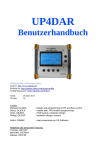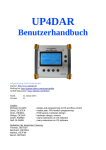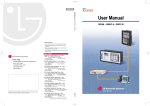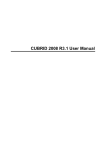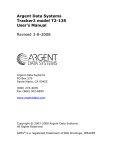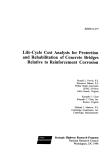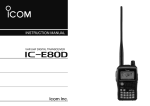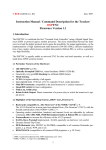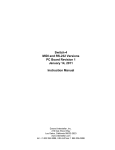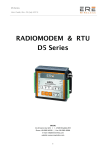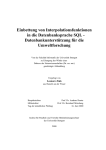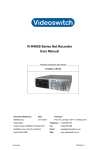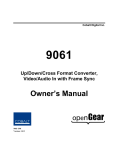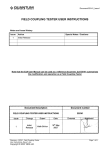Download BEDEROV GmbH
Transcript
BEDEROV GmbH Universal platform for digital amateur radio (UP4DAR) Draft 0.2 20.06.2012 Issued by Denis Bederov (DL3OCK) QTH: Berlin QRL: Salzburg © BEDEROV GmbH 2009-2012 © DL3OCK UP4DAR technical specification UP4DAR_Spec.odt Draft 0.2 Author: D. Bederov Released by: DL3OCK For no commercial use only! Date: 20/06/2012 Page 1 of 52 page(s) BEDEROV GmbH Contents 1 GENERAL INFORMATION................................................................................................................ 4 1.1 1.2 1.3 1.4 HISTORY........................................................................................................................................ 4 MAIN AUTHORS............................................................................................................................... 4 REFERENCES.................................................................................................................................. 5 ABBREVIATIONS AND DEFINITIONS.......................................................................................................... 6 2 PLATFORM OVERVIEW................................................................................................................... 7 2.1 HARDWARE ARCHITECTURE................................................................................................................. 7 2.2 USE CASES..................................................................................................................................... 8 2.2.1 Single user operation......................................................................................................... 8 2.2.2 Digipeater operation........................................................................................................... 8 2.3 ELECTRICAL CHARACTERISTICS............................................................................................................. 9 2.3.1 Connection to a TRX.......................................................................................................... 9 3 SPECIFICATION OF UP4DAR INTERFACE...................................................................................11 3.1 STATES OF PHY........................................................................................................................... 11 3.1.1 Service mode................................................................................................................... 12 3.1.2 Single user mode @ DSTAR-PHY...................................................................................12 3.1.3 Digipeater mode @ DSTAR-PHY....................................................................................13 3.1.4 DVR-mode @ DSTAR-PHY.............................................................................................14 3.1.5 APRS-PHY....................................................................................................................... 15 3.1.6 PR9K6-PHY..................................................................................................................... 15 3.2 PARAMETERS OF PHY.................................................................................................................... 16 3.3 COMMAND OVERVIEW...................................................................................................................... 17 3.4 COMMAND TRANSMISSION ORDER........................................................................................................ 17 3.5 COMMAND SPECIFICATION................................................................................................................. 17 3.5.1 sysInfo.............................................................................................................................. 18 3.5.2 SysParam........................................................................................................................ 18 3.5.3 reqSysParam................................................................................................................... 19 3.5.4 setSysParam.................................................................................................................... 19 3.5.5 uploadVoiceWarning........................................................................................................ 20 3.5.6 set_QRG.......................................................................................................................... 21 3.5.7 ind_QRG.......................................................................................................................... 21 3.5.8 modeInfo.......................................................................................................................... 22 3.5.9 set_mode......................................................................................................................... 22 3.5.10 cmd_exe_ind.................................................................................................................... 23 3.5.11 tx_on................................................................................................................................ 24 3.5.12 tx_off................................................................................................................................ 24 3.5.13 send_header.................................................................................................................... 24 3.5.14 send_voice....................................................................................................................... 25 3.5.15 send_data........................................................................................................................ 26 3.5.16 change_duration.............................................................................................................. 26 3.5.17 rcvd_header..................................................................................................................... 27 3.5.18 rcvd_voice........................................................................................................................ 27 3.5.19 rcvd_syncFlag.................................................................................................................. 28 3.5.20 rcvd_data......................................................................................................................... 28 3.5.21 rcvd_termFlag.................................................................................................................. 29 3.5.22 rcvd_FrameSync.............................................................................................................. 29 3.5.23 tx_test.............................................................................................................................. 30 3.6 PROCEDURES................................................................................................................................ 31 © DL3OCK UP4DAR technical specification UP4DAR_Spec.odt Draft 0.2 Author: D. Bederov Released by: DL3OCK For no commercial use only! Date: 20/06/2012 Page 2 of 52 page(s) BEDEROV GmbH 3.6.1 3.6.2 3.6.3 3.6.4 3.6.5 3.6.6 3.6.7 3.6.8 3.6.9 Power On procedure........................................................................................................ 31 Transmitting procedure.................................................................................................... 31 Aborted transmitting procedure........................................................................................33 Receiving procedure in SUM...........................................................................................35 Receiving procedure in DM.............................................................................................. 36 Procedure for receiving of unwanted signal in DM...........................................................37 Procedure for receiving of corrupted signal in DM...........................................................38 MATFST expiry procedure...............................................................................................41 PHY update procedure..................................................................................................... 43 4 ANNEX............................................................................................................................................. 44 4.1 FRAME STRUCTURE OF DV PACKET IN D-STAR...................................................................................44 4.2 DESCRIPTION OF D-STAR APPLICATION LAYER....................................................................................46 4.2.1 Mapping of LSDC............................................................................................................. 46 4.2.2 Empty voice data channel................................................................................................47 4.3 PROPOSALS FOR DESKTOP SOFTWARE................................................................................................. 51 4.3.1 GUI................................................................................................................................... 51 4.4 PROPOSAL FOR A LOW DELAY INTER DIGIPEATER TRANSMISSION..................................................................52 © DL3OCK UP4DAR technical specification UP4DAR_Spec.odt Draft 0.2 Author: D. Bederov Released by: DL3OCK For no commercial use only! Date: 20/06/2012 Page 3 of 52 page(s) BEDEROV GmbH 1 General information Currently there is no a lot solutions on market for the new digital voice operation mode in amateur radio. Especially the creating of innovation in such new and interesting area is not really easy by today. The target for the development of the universal platform for digital amateur radio (UP4DAR) is to create a very flexible platform with an open and good described interface. In my opinion this is a needed pre condition for enabling of a lot software talented YLs and OMs under us to create an always growing open source project, which should be open for all innovations we will have in the next future. The main goal of this document is to encourage and to enable a wide number of people interesting in digital amateur radio to develop software for the OS (definition follows in the next sections), desktop software for comfortable work (in case a computer is connected), each kind of back bone routing software for world wide interconnections (e.g. www.xreflector.net) and some really innovative things that there is not by today. I am hinting at new “network services” (e.g. digital routeable voice mailboxes, digipeater with special ports not for a voice communication but with special measuring functionality, which should report back to the user, which physical parameters would be more better to set in his hardware configuration menu, etc...). 1.1 History Version Date 0.1 29.11.09 all Changes / Reasons DL3OCK, initial version started on 04.11.2009 0.2 all DL3OCK 20.06.11 Chapter Rule for version number: • next integer number for major changes • + 0.1 for minor changes 1.2 Main Authors Denis Bederov (DL3OCK); [email protected] © DL3OCK UP4DAR technical specification UP4DAR_Spec.odt Draft 0.2 Author: D. Bederov Released by: DL3OCK For no commercial use only! Date: 20/06/2012 Page 4 of 52 page(s) BEDEROV GmbH 1.3 References [STD4] http://www.jarl.com/d-star/shiryou/STD4_3C.pdf [shogen] http://www.jarl.com/d-star/shogen.pdf [dvsi] AMBE-2020TM Vocoder Chip , User’s Manual , Version 4.8 September 2007 http://www.dvsinc.com/products/a2020.htm [APRS] APRS Protocol Reference – APRS Protocol Version 1.0 [3GPP] 3GPP TS 23.032 V8.0.0 (2008-12) Universal Geographical Area Description (GAD) http://www.3gpp.org/ftp/Specs/htmlinfo/23032.htm © DL3OCK UP4DAR technical specification UP4DAR_Spec.odt Draft 0.2 Author: D. Bederov Released by: DL3OCK For no commercial use only! Date: 20/06/2012 Page 5 of 52 page(s) BEDEROV GmbH 1.4 Abbreviations and definitions AF audio frequency APRS Automatic Position Reporting System is the trademark of Bob Bruninga, WB4APR digipeater digital repeater D-STAR Digital Smart Technologies for Amateur Radio DV digital voice FEC forward error protection GMSK Gaussian minimum shift keying HF high frequency LO-QRG frequency of local oscillator LSB least significant byte LSDC low speed data channel NMEA National Marine Electronics Association PLL phased lock loop PTT push to talk RX-QRG receiving frequency t.b.d. to be defined UP4DAR Universal platform for digital amateur radio © DL3OCK UP4DAR technical specification UP4DAR_Spec.odt Draft 0.2 Author: D. Bederov Released by: DL3OCK For no commercial use only! Date: 20/06/2012 Page 6 of 52 page(s) BEDEROV GmbH 2 Platform overview 2.1 Hardware architecture The universal platform for digital amateur radio (UP4DAR) is a very flexible, high integrated platform which allows to host many different digital communication procedures from the amateur radio area. The UP4DAR consists of two important parts: • Intelligent physical layer functionality (PHY) • Operating System functionality (OS) On the PHY the very time critical signal processing of incoming noisy AF signal is implemented. The PHY is connected to the amateur radio equipment by the traditional and well known data Mini-DIN 6 jack, which many transceiver by today have. The OS has a lot of purposeful components which should allow to implement many comfortable software applications with new innovative ideas. UP4DAR block diagram Salzburg, 02.04.2012 RS232 (TTL) (4) RX_AF JTAG (2) GND (1) TX_AF PHY (Physical Layer) 16.384MHz AT32UC3B1512Z1U (3) PTT Patch Field PTT cmdinterface AMBE2020 mic line out CODEC WM8510 µSD Card Holder OS SPK_out (Operating System) AT32UC3A1512 key6 USB OntheGo 12MHz RS232 MAX3232ECAE USB JTAG IO Expansion eth key5 key1 key2 key3 key4 Figure 1: UP4DAR block diagram © DL3OCK UP4DAR technical specification UP4DAR_Spec.odt Draft 0.2 Author: D. Bederov Released by: DL3OCK For no commercial use only! Date: 20/06/2012 Page 7 of 52 page(s) BEDEROV GmbH 2.2 Use cases 2.2.1 Single user operation The most common use case would be the usage of this universal platform as an end user equipment. At the following figure the corresponding scenario is shown. As already mentioned above the physical layer does not need any external squelch information. The internal state machine observed the incoming noisy AF signal and estimates the fact of any ongoing transmission. So the best sensitivity can be achieved if the available squelch is completely open! GPS mouse (1) TX_AF (4) RX_AF (3) PTT TRX RS232 PTT key6 mic key5 line out key1 SPK_out key2 key4 key3 Figure 2: UP4DAR as a single user equipment 2.2.2 Digipeater operation The UP4DAR can be also used for creating of a digital repeater. The PHY provides for this purpose some helpful feature. This allows to make a repeater on very simple way by using of a minimum of external components. The following figure shows how a digipeater can looks like. © DL3OCK UP4DAR technical specification UP4DAR_Spec.odt Draft 0.2 Author: D. Bederov Released by: DL3OCK For no commercial use only! Date: 20/06/2012 Page 8 of 52 page(s) BEDEROV GmbH TX (1) TX_AF (3) PTT RX Gateway PC RS232 (4) RX_AF key6 mic key5 line out SPK_out key1 key2 key4 key3 Figure 3: UP4DAR as a digipeater 2.3 Electrical characteristics 2.3.1 Connection to a TRX The analog connection towards an amateur transceiver is a usual Mini-DIN 6 jack, that a lot of transceivers of today have. The AF signal from receiver, which is connected to the pin 4, should be not higher than 660mVpp. On the input of the pin 4 inside is a series connection of a 4.7µF capacitance and a 11KOhm resistor. The “cold site” of the capacitance is negative, so the constant component of the input signal must be smaller than 1.3V. The maximal possible output AF signal at pin 1 has 2400mVpp. This output has a series capacitance of 4.7µF with a negative “cold site”, so the input of the transmitter must be DC free. Neither input nor output have any trimmer, so the level is controlled by software parameter (see 3.2) only! This should allow in the OS application software to store configuration for each particular amateur radio device. So a particular profile can be loaded ad hoc by connection to different transceiver (e.g. fixed station, transceiver © DL3OCK UP4DAR technical specification UP4DAR_Spec.odt Draft 0.2 Author: D. Bederov Released by: DL3OCK For no commercial use only! Date: 20/06/2012 Page 9 of 52 page(s) BEDEROV GmbH built in the car or a portable transceiver). Such configuration file can be also exchanged with other OMs using the same transceiver. Thank to a smart switching power supply concept the voltage of the power supply for UP4DAR can vary in a wide range from 4V to 20V. NOTE! The 5V supply is only working, if input power supply is in the range 6V...20V. NOTE! The 8V supply is only working, if input power supply is in the range 8.5V...20V. © DL3OCK UP4DAR technical specification UP4DAR_Spec.odt Draft 0.2 Author: D. Bederov Released by: DL3OCK For no commercial use only! Date: 20/06/2012 Page 10 of 52 page(s) BEDEROV GmbH 3 Specification of UP4DAR interface The “PHY” can be considered as a kind of a well known GMSK chip CMX589 extended with a couple of features. So we can now speak about an intelligent physical layer, which is closed source. In order to be able to develop the software for the operating system (OS) at UP4DAR the physical layer should be considered as a black box with strongly defined behaviour and well known interface. In this chapter the interface will be presented in detail. 3.1 States of PHY After power supply is switched on the physical layer starts to boot. After this very fast procedure is finished the PHY goes into servicemode. In the further operation also other modes are possible. Each operational mode of PHY can have different states. In the following figures all states are described in more detail. tx _o n[ ] tx _o ff [] „received termFlag“ or „transmission unexpected ends“ received „frameSync“ or „syncFlag“ rx-armed tx n[ _o tx ] rx-active Figure 4: states of UP4DAR in DSTAR-PHY-SUM mode © DL3OCK UP4DAR technical specification UP4DAR_Spec.odt Draft 0.2 Author: D. Bederov Released by: DL3OCK For no commercial use only! Date: 20/06/2012 Page 11 of 52 page(s) BEDEROV GmbH 3.1.1 Service mode As already mentioned the PHY goes in this state immediately after its has booted after the power was switched on. In this state some parameter of PHY (see 3.2) can be configured from outside via the UP4DAR interface by using of special commands described in the next sections. In order to adjust the level of transmitted AF signal some test sequences can be transmitted. Also the input of the PHY can be adjusted to the polarity of received AF-signal. 3.1.2 Single user mode @ DSTAR-PHY This mode is basically used in the most cases together with amateur radio transceiver for a direct QSO or operation via a digital repeater (digipeater). 3.1.2.1 rxarmed state In this state the PHY stays its most time and investigates the incoming noisy signal if there is a valid data transmission. It does mean that the PHY does not need any external squelch circuit. Therefore the best idea it is to open completely the squelch (if available). As soon a valid data transmission is detected the PHY goes to the next state. 3.1.2.2 rxactive state Being in this state the PHY provides to the OS the received voice data and data of low speed data channel (see 4). 3.1.2.3 tx state If the user want to make a digital voice transmission by activation of its PTT the OS enforces the PHY to go into the transmitting (tx) state. Being in this state the PHY get the data to be transmitted and creates a corresponding analogue GMSK AF signal. 3.1.2.4 txtermFlag state Should an ongoing transmission be finished the user simply deactivates the PTT. Thereupon the OS enforces the PHY to go into the txtermFlag state in which the PHY sends the terminating flag and deactivates the HF transmitter. Shortly after this the PHY changes to the rxarmed state. © DL3OCK UP4DAR technical specification UP4DAR_Spec.odt Draft 0.2 Author: D. Bederov Released by: DL3OCK For no commercial use only! Date: 20/06/2012 Page 12 of 52 page(s) BEDEROV GmbH 3.1.3 Digipeater mode @ DSTAR-PHY In this mode the PHY of the UP4DAR has all basic features needed to make a voice digital repeater according to D-STAR (see 4). A potential SysOp needs only to have a traditional analogue repeater equipment, in which the receiver has a data capable AF output and the transceiver a data capable AF input (see 2.2.2). In this mode the PHY has the same states like in the SUM rxarmed, rxactive, tx, txtermFlag with the same meaning as it was presented above. Additionally the digipeater mode (DM) has following states. received „frameSync“ or „syncFlag“ is sent. Whole buffer tx_o n[] tx_s top[ ] rx-active-tx ] top[ tx_s tx ed tt mi ns ra t g“ la mF er „t tx_off[] or „not at time“ rx-armed ot „n m ti t a e“ „MATFST expires“ tx_stop[] rx-active-tx-warning Voice warning finished, „termFlag“ transmitted. tx _o n[ ] „received termFlag“ or „transmission unexpected ends“ „received termFlag“ or „transmission unexpected ends“ tx-buffer „Received termFlag“ or „transmission unexpected ends“ tx-termFlag tx-warning rx-actvie tx_stop[] Voice warning finished, „termFlag“ transmitted. Figure 5: states of UP4DAR in DSTAR-PHY-DM mode 3.1.3.1 rxactivetx state This is most native state of a repeater, in which a valid data transmission is (almost) directly retransmitted immediately by PHY to the transmitter and in addition provided to the OS for further processing (e.g. sending of voice data and data of low speed data channel to a gateway function for establishing of an inter repeater operation). 3.1.3.2 txbuffer state In this state the PHY goes if a receiving transmission is finished in order to send out data still buffered (due to a time delay between incoming and outgoing digital signal). © DL3OCK UP4DAR technical specification UP4DAR_Spec.odt Draft 0.2 Author: D. Bederov Released by: DL3OCK For no commercial use only! Date: 20/06/2012 Page 13 of 52 page(s) BEDEROV GmbH 3.1.3.3 rxactivetxwarning state If the maximal allowed time for a single transmission in repeater mode is configured to be limited and this time was expired during a long transmission the PHY goes in this state. Here the PHY still provides received data to the OS but does not retransmit them to the AF output. Instead of received signal the PHY sends a short voice warning message (e.g. “Here is DB0DF. The last transmission was too long!” or simply “transmission too long!”). The data of the voice warning message can be uploaded into the PHY during configuration procedure. 3.1.3.4 txwarning state In this state the PHY goes if a too long transmission was finished during the voice warning is transmitting in order to finalize the completely voice warning message. 3.1.4 DVR-mode @ DSTAR-PHY received a DV transmission without any correct header rx-armed rx received a DV transmission without any correct header received correct header „received termFlag“ or „transmission unexpected ends“ tx DV R_ Ti me r_ 01 i s ex pi re d! „received termFlag“ or „transmission unexpected ends“ rx-active waiting_for_timer received correct header Max. recording time 60s! DVR_Timer_01 = 2s Figure 6: states of UP4DAR in DSTAR-PHY-DVR mode © DL3OCK UP4DAR technical specification UP4DAR_Spec.odt Draft 0.2 Author: D. Bederov Released by: DL3OCK For no commercial use only! Date: 20/06/2012 Page 14 of 52 page(s) BEDEROV GmbH 3.1.4.1 rxarmed state 3.1.4.2 rxactive state 3.1.4.3 waitingfortimer state 3.1.4.4 rx state 3.1.4.5 tx state t.b.d. 3.1.5 APRS-PHY t.b.d. 3.1.6 PR9K6-PHY t.b.d © DL3OCK UP4DAR technical specification UP4DAR_Spec.odt Draft 0.2 Author: D. Bederov Released by: DL3OCK For no commercial use only! Date: 20/06/2012 Page 15 of 52 page(s) BEDEROV GmbH 3.2 Parameters of PHY The physical layer can be optimised to his environment by configuration of following parameters: Parameter name Value(s) Description 0..255 Transmitter delay time between PTT activation and transmission of information data in 8bit steps (additionally to 64 mandatory bits!). For a D-STAR voice frame this means that after activation of PTT the sequence {1,0,1,0,1,0,...,1,0} of length TX_DELAY*8+64 in front of FrameSync flag is transmitted. ID TX_DELAY 0x01 TX_GAIN 0x02 128..1, Linear factor for transmitted AF signal. The maximal range of DAC is achieved if TX_GAIN = 127. By using of negative 1,..127 values of TX_GAIN the output AF signal can be inverted, if it is needed. RX_inv 0x03 0,1 If the incoming AF signal is inverted (due to an inverting amplifier some where in receiver or if in a IF-mixer LO-QRG > RX-QRG for instance) RX_inv should be set to 1. TX_DC_SHIFT 0x04 128..127 This parameter describes the linear offset of transmitted signal. It is relevant for DC-coupled transmitter only. MATFST 0x05 0..255 Maximal allowed time for a single transmission in digipeater mode in 2sec steps. The time is not limited if MATFST=0 . Length_of_VW 0x06 1..255 © DL3OCK Number of 20ms blocks of recorded voice warning message for user information about MATFST expiry. UP4DAR technical specification UP4DAR_Spec.odt Draft 0.2 Author: D. Bederov Released by: DL3OCK For no commercial use only! Date: 20/06/2012 Page 16 of 52 page(s) BEDEROV GmbH 3.3 Command ID 0x01 Command overview Service Mode ready SysInfo[] / req_SysInfo[] 0x10 0x11 tx tx_test[] DSTAR-PHY-SUM rx-active rx-armed rx-armed rx-active DSTAR-PHY-DVR rx Waiting-for-timer tx rx-armed DSTAR-PHY-DM rx-active rx tx tx_on[] tx_off[] tx_off[] 0x20 0x21 0x22 0x23 send_header[] send_voice[] send_data[] change_duration[] 0x30 0x31 0x32 0x33 0x34 0x35 rcvd_header[] rcvd_voice[] rcvd_SyncFlag[] rcvd_data[] rcvd_termFlag[] rcvd_header[] rcvd_header[] rcvd_voice[] rcvd_data[] rcvd_termFlag[] rcvd_FrameSync[] 0x40 0x41 0x42 rcvd_FrameSync[] SysParam[] req_SysParam[] set_SysParam[] 0x44 0x45 set_QRG[] ind_QRG[] 0xD1 modeInfo[] 0xD3 0xD4 0xE1 0xE2 0xE3 0xE4 tx set_mode[] cmd_exe_ind[] modeInfo[] modeInfo[] set_mode[] cmd_exe_ind[] set_mode[] cmd_exe_ind[] start_update[] transfer_update_block[] update_cmplt[] rdy_for_update[] 3.4 Command transmission order Alle messages on command interface are encapsulated in the structure <DLE><STX> .......<DLE><ETX>, with the usual values as follow: <DLE> = 0x10 <STX> = 0x02 <ETX> = 0x03 In case that the encapsulated payload has a Byte 0x10 (which is equal to <DLE>), then this byte 0x10 should be doubled. All commands as well responses are transmitted serial over the UP4DAR command interface byte wise. Each particular byte is transmitted with LSB first. Example: modeInfo[mode=service_mode, status=ready] is transmitted as 0x10,0x02,0xD1,0x01,0x00,0x10,0x03. For the physical transfer one of typical USART ports is used. The configuration of this port is [8N1, LSB first, 115200Baud] 3.5 Command specification In the following section the syntax of all commands is described in detail. © DL3OCK UP4DAR technical specification UP4DAR_Spec.odt Draft 0.2 Author: D. Bederov Released by: DL3OCK For no commercial use only! Date: 20/06/2012 Page 17 of 52 page(s) BEDEROV GmbH 3.5.1 sysInfo Syntax: sysInfo[version] Length of the command: 70Byte. Parameter Value(s) Description Command name sysInfo This command informs the OS about the version of currently used PHY software. This commands is only sends immediately after PHY was powered on. This command can also be sent to the PHY as request at any time to get the sysInfo! 0x01 Command ID byte1,..., byte70 version 3.5.2 Last 15 Bytes are the ATMEL's unique serial number of the UC3B-Chip SysParam Syntax: SysParam[parameter, value] Length of the command: 3Byte. Parameter Value(s) Description Command name SysParam This command shows the content of any particular parameter. 0x40 Command ID parameter 0x01 = TXDELAY 0x02 = TXGAIN 0x03 = RXinv 0x04 = TCDCSHIFT 0x05 = MATFST 0x06 = Length_of_VW byte1 value © DL3OCK UP4DAR technical specification UP4DAR_Spec.odt Draft 0.2 Author: D. Bederov Released by: DL3OCK For no commercial use only! Date: 20/06/2012 Page 18 of 52 page(s) BEDEROV GmbH 3.5.3 reqSysParam Syntax: reqSysParam[parameter] Length of the command: 2Byte. Parameter Command name Value(s) Description reqSysParam This command requests the information about any particular parameter. 0x41 Command ID 0x01 = TXDELAY parameter 0x02 = TXGAIN 0x03 = RXinv 0x04 = TXDCSHIFT 0x05 = MATFST 0x06 = Length_of_VW 3.5.4 setSysParam Syntax: setSysParam[parameter, value] Length of the command: 3Byte. Parameter Command name Description setSysParam This command allows to change any particular parameter. 0x42 Command ID parameter Value(s) 0x01 = TXDELAY 0x02 = TXGAIN 0x03 = RXinv 0x04 = TXDCSHIFT 0x05 = MATFST 0x06 = Length_of_VW byte1 value © DL3OCK UP4DAR technical specification UP4DAR_Spec.odt Draft 0.2 Author: D. Bederov Released by: DL3OCK For no commercial use only! Date: 20/06/2012 Page 19 of 52 page(s) BEDEROV GmbH 3.5.5 uploadVoiceWarning Syntax: uploadVoiceWarning[Length_of_VW, voice_message] Length of the command: depending on Length_of_VW. Parameter Command name Value(s) Description uploadVoiceWarning This command allows to upload into PHY the voice data for a voice warning about expiry of maximal allowed time for single transmission. Command ID 0x43 Length_of_VW 1..255 voice_message byte1..byteN © DL3OCK Number of 20ms blocks of recorded voice warning message for user information about MATFST expiry. N = Length_of_VW * 9 UP4DAR technical specification UP4DAR_Spec.odt Draft 0.2 Author: D. Bederov Released by: DL3OCK For no commercial use only! Date: 20/06/2012 Page 20 of 52 page(s) BEDEROV GmbH 3.5.6 set_QRG Syntax: set_QRG[rx_QRG, tx_QRG] Length of the command: 9Byte. Parameter Value(s) Description Command name set_QRG This command allows to set the transmission and receiving frequency of a radio part, which is directly connected to the PHY. 0x44 Command ID byte1..byte4 rx_QRG unsigned int rx_QRG; byte1 = MSB, ..., byte4=LSB byte1..byte4 tx_QRG unsigned int tx_QRG; byte1 = MSB, ..., byte4=LSB 3.5.7 ind_QRG Syntax: ind_QRG[set_QRG_resp] Length of the command: 2Byte. Parameter Value(s) Description Command name ind_QRG This command responses if the seting of new frequences was successful or not. 0x45 Command ID set_QRG_resp 0x00 = both QRGs set up 0x01 = txQRG is out of allowed range 0x02 = rxQRG is out of allowed range 0x03 = PLL is not able to lock txQRG 0x04 = PLL is not able to lock txQRG © DL3OCK UP4DAR technical specification UP4DAR_Spec.odt Draft 0.2 Author: D. Bederov Released by: DL3OCK For no commercial use only! Date: 20/06/2012 Page 21 of 52 page(s) BEDEROV GmbH 3.5.8 modeInfo Syntax: modeInfo[mode, state] Length of the command: 3Byte. Parameter Value(s) Description Command name modeInfo This command provides the information about the current operation mode / state. 0xD1 This id is from the mode independent range [0xD1...0xFF, 0x00] Command ID 0x01 = servicemode mode 0x02 = DSTARPHYSUM 0x03 = DSTARPHYDM 0x04 = DSTARPHYDVR 0x05 = APRSPHY 0x06 = PR9K6PHY 0x07 = F3EPHY 0x00 = ready state “ready” is used in “servicemode” only. 0x01 = rxarmed 0x02 = rxactive 0x03 = rx 0x04 = tx 0x05 = txtermFlag 0x06 = rxactivetx 0x07 = txbuffer 0x08 = rxactivetxwarning 0x09 = txwarning 0x0A = waiting_for_timer 3.5.9 set_mode Syntax: set_mode[mode] Length of the command: 2Byte. Parameter Value(s) Description Command name set_mode This command enforces the PHY to change in some particular operation mode. © DL3OCK UP4DAR technical specification UP4DAR_Spec.odt Draft 0.2 Author: D. Bederov Released by: DL3OCK For no commercial use only! Date: 20/06/2012 Page 22 of 52 page(s) BEDEROV GmbH 0xD3 Command ID This id is from the mode independent range [0xD1...0xFF, 0x00] 0x01 = servicemode mode 0x02 = DSTARPHYSUM 0x03 = DSTARPHYDM 0x04 = DSTARPHYDVR 0x05 = APRSPHY 0x06 = PR9K6PHY 0x07 = F3EPHY 3.5.10 cmd_exe_ind Syntax: cmd_exe_ind[executionstatus] Length of the command: 2Byte. Parameter Command name Command ID execution_status Value(s) Description cmd_exe_ind This command provides the feedback about the execution of recently invoked command. 0xD4 This id is from the mode independent range [0xD1...0xFF, 0x00] 0x01 = successful execution 0x02 = command is not specified or can not be used in the current situation 0x03 = syntax error 0x04 = command queue of PHY was busy © DL3OCK UP4DAR technical specification UP4DAR_Spec.odt Draft 0.2 Author: D. Bederov Released by: DL3OCK For no commercial use only! Date: 20/06/2012 Page 23 of 52 page(s) BEDEROV GmbH 3.5.11 tx_on Syntax: tx_on[] Length of the command: 1Byte. Parameter Value(s) Command name tx_on Command ID 0x10 3.5.12 Description This command starts a regular DV transmission. tx_off Syntax: tx_off[] Length of the command: 1Byte. Parameter Command name Description tx_off This command stops an ongoing DV transmission on a regular way by appending of the terminating flags. 0x11 Command ID 3.5.13 Value(s) send_header Syntax: send_header[header_bytes] Length of the command: 40Byte. Parameter Command name Value(s) Description send_header This command provides to the PHY all needed bytes for a header transmission according to DSTAR protocol specification. Command ID 0x20 header_bytes byte1,..., byte39 © DL3OCK UP4DAR technical specification UP4DAR_Spec.odt Draft 0.2 Author: D. Bederov Released by: DL3OCK For no commercial use only! Date: 20/06/2012 Page 24 of 52 page(s) BEDEROV GmbH 3.5.14 send_voice Syntax: send_voice[VFI, voice_bytes] Length of the command: depending on VFI. Parameter Command name Value(s) Description send_voice This command provides to the PHY encoded bytes of 20ms speech period. 0x21 Command ID 0x01 = 2400/1200 BC FEC VFI 0x02 = 2400 voice_bytes See [dvsi] section 5.2.4 for further information. In current release the voice format indicator (VFI) = (2400/1200 BC FEC) is supported only. (VFI = 0x01): byte1,..., byte9 © DL3OCK UP4DAR technical specification UP4DAR_Spec.odt Draft 0.2 Author: D. Bederov Released by: DL3OCK For no commercial use only! Date: 20/06/2012 Page 25 of 52 page(s) BEDEROV GmbH 3.5.15 send_data Syntax: send_data[data] Length of the command: 4Byte. Parameter Command name Value(s) Description send_data This command provides to the PHY the data bytes of the low speed data channel for current 20ms. 0x22 Command ID byte1,..., byte3 data 3.5.16 change_duration Syntax: change_duration[n] Length of the command: 2Byte. Parameter Command name Value(s) Description change_duration This command allows to overcome the slip problem by faster or slower provision of information to send during the transmission. Usage of this command in front of each SyncFlag can adjust the own transmission up to +-99ppm in comparison to 4800Symbols per second! 0x23 Command ID 0x01 = duration 2x(10%) n 0x02 = duration 2x10% © DL3OCK This command can be used once in between of two SyncFlag. Two last symbols in front of following SyncFlag will be ether extended or shorted by 10% of its regular duration. UP4DAR technical specification UP4DAR_Spec.odt Draft 0.2 Author: D. Bederov Released by: DL3OCK For no commercial use only! Date: 20/06/2012 Page 26 of 52 page(s) BEDEROV GmbH 3.5.17 rcvd_header Syntax: rcvd_header[crc_result, header_bytes] Length of the command: 41Byte. Parameter Command name Value(s) Description rcvd_header This command provides the received and decoded header payload. 0x30 Command ID 0x00 = CRC was OK crc_result 0x01 = bad CRC header_bytes 3.5.18 byte1,..., byte39 For the mapping of the header byte see [STD4], [shogen] or 4.1. rcvd_voice Syntax: rcvd_voice[VFI, voice_bytes] Length of the command: depending on VFI. Parameter Command name Value(s) Description rcvd_voice This command provides the received voice data. 0x31 Command ID 0x01 = 2400/1200 BC FEC VFI 0x02 = 2400 0x20 = 2400/1200 BC FEC SD voice_bytes See [dvsi] section 5.2.4 for further information. In current release the voice format indicator (VDF) = (2400) is not supported. (VFI = 0x01): byte1,..., byte9 (VFI = 0x20): byte1,..., byte36 © DL3OCK UP4DAR technical specification UP4DAR_Spec.odt Draft 0.2 Author: D. Bederov Released by: DL3OCK For no commercial use only! Date: 20/06/2012 Page 27 of 52 page(s) BEDEROV GmbH 3.5.19 rcvd_syncFlag Syntax: rcvd_syncFlag[time_correction] Length of the command: 2Byte. Parameter Command name Value(s) Description rcvd_syncFlag This command indicates that a sync flag was received and provides the done time correction in respect to the recently received sync flag before. 0x32 Command ID tc_byte time_correction 0 <= tc_byte <= 13 The time correction value gives a result of the measured time difference between the received Synchronisation Flag and its ideal time point. Based on this measurement it is possible to calculate the relative time/frequency error between the transmitter and the receiver crystal according to the following formula: error_in_ppm:= (tc_byte-7)*84 3.5.20 rcvd_data Syntax: rcvd_data[n, data] Length of the command: 5Byte. Parameter Command name Value(s) Description rcvd_data This command provides the received data of the low speed data channel. Command ID 0x33 n 1..20 Number of current received block counted since the last sync flag. byte1,..., byte3 data © DL3OCK UP4DAR technical specification UP4DAR_Spec.odt Draft 0.2 Author: D. Bederov Released by: DL3OCK For no commercial use only! Date: 20/06/2012 Page 28 of 52 page(s) BEDEROV GmbH 3.5.21 rcvd_termFlag Syntax: rcvd_termFlag[] Length of the command: 1Byte. Parameter Command name Value(s) Description rcvd_termFlag This command indicates that a termination flag was received. 0x34 Command ID 3.5.22 rcvd_FrameSync Syntax: rcvd_FrameSync[mean, deviation_x2, samples] Length of the command: 93Byte Parameter Command name Value(s) Description rcvd_FrameSync This command provides the analogue samples of received FrameSync-Flag. 0x35 Command ID mean 0..0xFF Mean value of the received signal deviation_x2 0..0xFF The doubled peak deviation of the received signal (calculated based on FrameSync). samples byte1,..., byte90 The frame sync flag consist of 15 symbols which are represented by 6 samples per symbol. means ground level and 0xff means VCC level of RX_AF (pin4). 0x00 © DL3OCK UP4DAR technical specification UP4DAR_Spec.odt Draft 0.2 Author: D. Bederov Released by: DL3OCK For no commercial use only! Date: 20/06/2012 Page 29 of 52 page(s) BEDEROV GmbH 3.5.23 tx_test Syntax: tx_test[sequence] Length of the command: 2Byte. Parameter Value(s) Description Command name tx_test This command enforces the PHY to transmit some predefined periodical signals. This is very helpful for adjustment activity by connection of UP4DAR to a new amateur radio equipment. 0x10 Command ID sequence 0x01 = “1111100000...” 0x02 = PRN9 © DL3OCK This test data sequences are transmitted with 9600Baud! UP4DAR technical specification UP4DAR_Spec.odt Draft 0.2 Author: D. Bederov Released by: DL3OCK For no commercial use only! Date: 20/06/2012 Page 30 of 52 page(s) BEDEROV GmbH 3.6 Procedures In this section all important procedures are presented as formal message flows. 3.6.1 Power On procedure OS PHY sysInfo[64byte] modeInfo[mode=servicemode, state=ready] Figure 7: Power On procedure After the power on was switched on the PHY starts its operation. After the boot process is finished the PHY sends a sysInfo with a string of 70 bytes and a modeInfo message as shown in the figure above. 3.6.2 Transmitting procedure In the DSTAR-PHY-SUM as well in DSTAR-PHY-DM the transmitting procedure is executing on the same way as shown in the figure below. The main work for creating the output AF signal is done by PHY so the program on the OS does not need to take care about. However it is very important to fulfil the timing requirements of a D-STAR DV frame, which is shown with blue arrow on the right site of the PHY instance. © DL3OCK UP4DAR technical specification UP4DAR_Spec.odt Draft 0.2 Author: D. Bederov Released by: DL3OCK For no commercial use only! Date: 20/06/2012 Page 31 of 52 page(s) BEDEROV GmbH OS PHY tx_on[] (TX_DELAY*8+64+15)/4800 cmd_exe_ind[succesful] send_header[39byte] 65ms cmd_exe_ind[succesful] send_voice[VFI, 9byte] cmd_exe_ind[succesful] send_syncFlag[] 20ms cmd_exe_ind[succesful] send_voice[VFI, 9byte] cmd_exe_ind[succesful] send_data[3byte] 20ms cmd_exe_ind[succesful] send_voice[VFI, 9byte] cmd_exe_ind[succesful] send_data[3byte] 20ms cmd_exe_ind[succesful] tx_off[] 14ms cmd_exe_ind[succesful] modeInfo[mode, state=rxarmed] Figure 8: transmitting procedure © DL3OCK UP4DAR technical specification UP4DAR_Spec.odt Draft 0.2 Author: D. Bederov Released by: DL3OCK For no commercial use only! Date: 20/06/2012 Page 32 of 52 page(s) BEDEROV GmbH 3.6.2.1 Abnormal behavior As soon the OS does not provide the next portion of needed data during the transmitting procedure at time the PHY finishes the transmission on correct way. The OS will be informed by indicating of change into the corresponding state. The PHY will reject all further data coming not at time. 3.6.3 Aborted transmitting procedure This procedure is executed on very native way and does not really need to be mentioned in an extra section. The only reason for this section is to give an idea how the internally command pipeline of the PHY works. The assumption here is that it is going about some kind of voice mail application or transmitting of any information, which was already recorded and stored. In such a case the OS can provide to the PHY all the voice (and LSDC) data in very short time interval much shorter than the corresponding “play” time. This data can be easily received and stored in the PHY. However the real time transmitting will of course need the corresponding “play” time anyway. If in such a scenario the OS decides whatever reasons to stop the transmission it simply sends the tx_stop[] command to the PHY. In this case the PHY immediately stops the transmission, deletes the data buffer and goes in the rx armed state. This procedure is shown in the following figure. © DL3OCK UP4DAR technical specification UP4DAR_Spec.odt Draft 0.2 Author: D. Bederov Released by: DL3OCK For no commercial use only! Date: 20/06/2012 Page 33 of 52 page(s) BEDEROV GmbH OS PHY tx_on[] (TX_DELAY*8+64+15)/4800 cmd_exe_ind[succesful] send_header[39byte] cmd_exe_ind[succesful] send_voice[VFI, 9byte] cmd_exe_ind[succesful] send_syncFlag[] cmd_exe_ind[succesful] send_voice[VFI, 9byte] cmd_exe_ind[succesful] send_data[3byte] cmd_exe_ind[succesful] send_voice[VFI, 9byte] 65ms cmd_exe_ind[succesful] send_data[3byte] cmd_exe_ind[succesful] tx_off[] 20ms cmd_exe_ind[succesful] tx_stop[] cmd_exe_ind[succesfull] modeInfo[mode, state=rxarmed] Figure 9: aborted transmitting procedure © DL3OCK UP4DAR technical specification UP4DAR_Spec.odt Draft 0.2 Author: D. Bederov Released by: DL3OCK For no commercial use only! Date: 20/06/2012 Page 34 of 52 page(s) BEDEROV GmbH 3.6.4 Receiving procedure in SUM OS PHY 65ms modeInfo[mode=DSTARPHYSUM, state=rxactive] 20ms rcvd_header[crc_result, 39byte] rcvd_voice[VFI, 36byte] 20ms rcvd_syncFlag[time_correction] rcvd_voice[VFI,36byte] 20ms rcvd_data[n, 3byte] rcvd_voice[VFI, 36byte] 14ms rcvd_data[n, 3byte] rcvd_termFlag[] modeInfo[mode=DSTARPHYSUM, state=rxarmed] Figure 10:receiving procedure in SUM © DL3OCK UP4DAR technical specification UP4DAR_Spec.odt Draft 0.2 Author: D. Bederov Released by: DL3OCK For no commercial use only! Date: 20/06/2012 Page 35 of 52 page(s) BEDEROV GmbH 3.6.5 Receiving procedure in DM The PHY-TX instance is only introduced to give an idea how PHY will internally work. This should improve understanding of timings in Digipeater mode. OS PHY PHY-TX 65ms (TX_DELAY*8+64+15)/4800 > 65ms modeInfo[mode=DSTARPHYDM, state=rxactivetx] 20ms rcvd_header[crc_result, 39byte] send_header[39byte] cmd_exe_ind[succesfull] rcvd_voice[VFI, 36byte] 65ms rcvd_voice[VFI, 36byte] 20ms rcvd_syncFlag[time_correction] 20ms rcvd_voice[VFI, 36byte] 20ms rcvd_data[n, 3byte] rcvd_termFlag[] 20ms 14ms rcvd_data[n, 3byte] 14ms 20ms modeInfo[mode=DSTARPHYDM, state=txbuffer] modeInfo[mode=DSTARPHYDM, state=rxarmed] Figure 11: receiving procedure in DM © DL3OCK UP4DAR technical specification UP4DAR_Spec.odt Draft 0.2 Author: D. Bederov Released by: DL3OCK For no commercial use only! Date: 20/06/2012 Page 36 of 52 page(s) BEDEROV GmbH 3.6.5.1 Abnormal behavior If the OS does not provide the header information for the retransmitted signal at time the PHY finishes the transmission. However the PHY will still provide the received data to the OS while the current received transmission is ongoing. 3.6.6 Procedure for receiving of unwanted signal in DM OS PHY PHY-TX 65ms (TX_DELAY*8+64+15)/4800 > 65ms modeInfo[mode=DSTARPHYDM, state=rxactivetx] rcvd_header[crc_result, 39byte] tx_stop[] *) rcvd_voice[VFI, 36byte] 20ms cmd_exe_ind[succesfull] rcvd_voice[VFI, 36byte] 20ms rcvd_syncFlag[time_correction] *) modeInfo[mode=DSTARPHYDM, state=rxactive] rcvd_voice[VFI, 36byte] 20ms rcvd_data[n, 3byte] 14ms rcvd_data[n, 3byte] rcvd_termFlag[] modeInfo[mode=DSTARPHYDM, state=rxarmed] Figure 12: aborting of a unwanted retransmission in DM © DL3OCK UP4DAR technical specification UP4DAR_Spec.odt Draft 0.2 Author: D. Bederov Released by: DL3OCK For no commercial use only! Date: 20/06/2012 Page 37 of 52 page(s) BEDEROV GmbH With this procedure the OS has a chance to stop the retransmission of unwanted signal. This is the case if the just received header does not fulfil some particular requirements for digipeating. 3.6.7 Procedure for receiving of corrupted signal in DM If a transmission does not have header information due to some reasons we are speaking about a corrupted transmission. This is the case if the transmitting mobile station was not receivable due to fading or if the receiver of the repeater was just switched on. In such case the PHY goes into rxactivetx state by receiving of the next synchronization flag as following figure shows. In comparison to the receiving procedure in DM (presented in 3.6.5) where the retransmission stops if we do not make any action in time, the received corrupted signal will be retransmitted while it is ongoing. © DL3OCK UP4DAR technical specification UP4DAR_Spec.odt Draft 0.2 Author: D. Bederov Released by: DL3OCK For no commercial use only! Date: 20/06/2012 Page 38 of 52 page(s) BEDEROV GmbH OS PHY PHY-TX 20ms (TX_DELAY*8+64+15)/4800 > 65ms modeInfo[mode=DSTARPHYDM, state=rxactivetx] rcvd_voice[VFI, 9byte] 20ms rcvd_data[n, 3byte] rcvd_voice[VFI, 9byte] 20ms 20ms rcvd_data[n, 3byte] rcvd_voice[VFI, 9byte] 20ms 20ms rcvd_data[n, 3byte] rcvd_voice[VFI, 9byte] 14ms 20ms rcvd_data[n, 3byte] rcvd_termFlag[] 14ms modeInfo[mode=DSTARPHYDM, state=txbuffer] modeInfo[mode=DSTARPHYDM, state=rxarmed] Figure 13: receiving of corrupted signal in DM © DL3OCK UP4DAR technical specification UP4DAR_Spec.odt Draft 0.2 Author: D. Bederov Released by: DL3OCK For no commercial use only! Date: 20/06/2012 Page 39 of 52 page(s) BEDEROV GmbH 3.6.7.1 Abnormal behavior If a retransmission of a corrupted signal is not desired the OS can stop the retransmission during the transmitter power on time (given by TXDELAY). The PHY provides the received data to the OS anyway. The following picture shows this approach. OS PHY PHY-TX 20ms (TX_DELAY*8+64+15)/4800 > 65ms modeInfo[mode=DSTARPHYDM, state=rxactivetx] rcvd_voice[VFI, 36byte] rcvd_syncFlag[time_correction] tx_stop[] 20ms cmd_exe_ind[succesfull] modeInfo[mode=DSTARPHYDM, state=rxactive] rcvd_voice[VFI, 36byte] 20ms rcvd_data[n, 3byte] rcvd_voice[VFI, 36byte] 14ms rcvd_data[n, 3byte] rcvd_termFlag[] modeInfo[mode=DSTARPHYDM, state=rxarmed] Figure 14: stopping of retransmission of a corrupted signal in DM © DL3OCK UP4DAR technical specification UP4DAR_Spec.odt Draft 0.2 Author: D. Bederov Released by: DL3OCK For no commercial use only! Date: 20/06/2012 Page 40 of 52 page(s) BEDEROV GmbH MATFST expiry procedure OS PHY PHY-TX MATFST expired 3.6.8 rcvd_voice[VFI, 36byte] rcvd_syncFlag[time_correction] rcvd_voice[VFI, 36byte] 20ms modeInfo[mode=DSTARPHYDM, state=rxactivetxwarning] „Voice Warning“ rcvd_voice[VFI, 36byte] 20ms rcvd_data[n, 3byte] rcvd_voice[VFI, 36byte] 20ms rcvd_data[n, 3byte] modeInfo[mode=DSTARPHYDM, state=rxactive] 14ms rcvd_syncFlag[time_correction] 20ms rcvd_voice[VFI, 36byte] 20ms rcvd_data[n, 3byte] rcvd_voice[VFI, 36byte] rcvd_voice[VFI, 36byte] 20ms rcvd_data[n, 3byte] 14ms rcvd_data[n, 3byte] rcvd_termFlag[] modeInfo[mode=DSTARPHYDM, state=rxarmed] Figure 15: MATFST expiry procedure in DM If a received transmission is ongoing longer than the MATFST than the PHY stops the retransmission and sends a short voice warning message for indicating of MATFST expiry. The PHY provides the received data to the OS anyway. 3.6.8.1 Abnormal behavior The following picture shows how the MATFST expiry procedure will be performed if the received transmission stops in the time period of an ongoing voice warning message. © DL3OCK UP4DAR technical specification UP4DAR_Spec.odt Draft 0.2 Author: D. Bederov Released by: DL3OCK For no commercial use only! Date: 20/06/2012 Page 41 of 52 page(s) BEDEROV GmbH PHY PHY-TX MATFST expired OS rcvd_voice[VFI, 36byte] rcvd_syncFlag[time_correction] 20ms modeInfo[mode=DSTARPHYDM, state=rxactivetxwarning] rcvd_voice[VFI, 36byte] rcvd_voice[VFI, 36byte] „Voice Warning“ 20ms rcvd_data[n, 3byte] 14ms rcvd_data[n, 3byte] rcvd_termFlag[] 14ms modeInfo[mode=DSTARPHYDM, state=txwarning] modeInfo[mode=DSTARPHYDM, state=rxarmed] Figure 16: stopped transmission during an ongoing voice warning message © DL3OCK UP4DAR technical specification UP4DAR_Spec.odt Draft 0.2 Author: D. Bederov Released by: DL3OCK For no commercial use only! Date: 20/06/2012 Page 42 of 52 page(s) BEDEROV GmbH 3.6.9 PHY update procedure PHY OS start_update[] rdy_for_update[] transfer_update_block[0,...,511] cmd_exe_ind[successful_execution] transfer_update_block[0,...,511] cmd_exe_ind[successful_execution] update_cmplt[] sysInfo[] Figure 17: PHY update procedure © DL3OCK UP4DAR technical specification UP4DAR_Spec.odt Draft 0.2 Author: D. Bederov Released by: DL3OCK For no commercial use only! Date: 20/06/2012 Page 43 of 52 page(s) BEDEROV GmbH 4 Annex 4.1 Frame structure of DV packet in D-STAR A the D-STAR System has two different operation modes: • digital voice (DV) • digital data (DD) In this document the DV mode is considered only. On the following figure the structure of a typical DV radio frame is presented. 1. The preamble of radio frame according [shogen] consists of 64 bits (alternating 1 und 0). Based on the fact, that conventional amateur transmitter needs more time to lock its PLL after the PTT was activated, the preamble is transmitted up to 550bits (and longer), before the “frame sync” will be started. 2. The „frame sync“ is following bit pattern: {1,1,1,0,1,1,0,0,1,0,1,0,0,0,0}. 3. The “sync flag” consists of following bit pattern: {1,0,1,0,1,0,1,0,1,0} + {1,1,0,1,0,0,0} + {1,1,0,1,0,0,0}. The „sync flag“ is transmitted in the 1 st and than in each 21th data time slot. The „sync flag“ is used in the receiver for correction of time synchronization to the transmitter as well it is used as preamble in case if the receiver was switched on during an ongoing transmission and missed the regular header. 4. The “terminating flag” is send at the end of the ongoing transmission in order to indicate a regular end of it. The “terminating flag” consists of {1,0,1,0,...,1,0,1,0}32 Bit+ {0,0,0,1,0,0,1,1,0,1,0,1,1,1,1,0} 16Bit. After that approximately 20 Zeros or Ones are send. The Transmitter is switched of (PTT deactivation) after 10th such Zero or One. © DL3OCK UP4DAR technical specification UP4DAR_Spec.odt Draft 0.2 Author: D. Bederov Released by: DL3OCK For no commercial use only! Date: 20/06/2012 Page 44 of 52 page(s) Author: D. Bederov 1 Byte 1 Byte 1 Byte © DL3OCK 8 Byte 8 Byte UP4DAR technical specification Draft 0.2 For no commercial use only! 660 Bit scrambling Date: 64...550 Bit 15 Bit CRC 16 Bit 660 Bit Radio frame header Initialisation of scrambler 660 Bit interleaving 1,0,1,0...,0,10 (1 frame sync (2 8 Byte Counterpart call sign Convolutional coder „1/2“ 328 Bit 312 Bit Send repeater call sign 660 Bit Rcv repeater call sign Convolutional coding CRC Flag 1 Flag 2 Flag 3 8 Byte 2 tail bits Own call sign 1 4 Byte 72 Bit voice time slot Own call sign 2 24 Bit Sync flag (3 voice time slot 24 Bit data time slot 72 Bit Conv. coder „2/3“ Conv. coder „2/3“ 72 Bit 48 Bit DVSI Algorithm 2560 Bit 20ms 48 Bit DVSI Algorithm 2560 Bit 20ms 2560 Bit 20ms voice time slot 72 Bit data time slot Conv. coder „2/3“ 48 Bit DVSI Algorithm Voice samples: 16Bit * 8000s 1 AMBE2020 voice time slot sync flag 24 Bit CRC voice time slot 24 Bit data time slot 20*24 Bit every 21*20=420ms 24 Bit User data in Low Speed Data Channel (optional) voice time slot Initialisation of scrambler 48 Bit terminating flag (4 scrambling Periodical output of data while the current transmission is ongoing. every 420msec Approx. every 2sec Approx. every 30sec CSQL=XX, etc... NMEA data TXMessage (20 Byte) 16 Bit Simple but proprietary packeting of ICOM 312 Bit Original header BEDEROV GmbH each 21⋅n1th data time slot, where n⊂ℕ Figure 18: D-STAR radio frame structure in DV mode Released by: DL3OCK UP4DAR_Spec.odt 20/06/2012 Page 45 of 52 page(s) BEDEROV GmbH 4.2 Description of D-STAR application layer As already presented a DV radio frames transmits together with digital voice data also user data in so called low speed data channel (LSDC). In this section the bit mapping and organization of data in LSDC of current commercial available D-STAR capable amateur radio transceiver should be discussed. Based on this information a outlook for potential future extensions can be given. 4.2.1 Mapping of LSDC Each 21th data time slot is used for synchronization issues. The remaining subsequent received 20 data slots in between (3 bytes each of them) builds 10 subsequent data containers. Each data container has therefore exactly 6 bytes. The 1st byte indicates how the remaining 5 bytes of this container are used. Thereby the 1st hex digit means the container's type and the 2 nd hex digit indicates how many following bytes of remaining 5 are used. The unused bytes are set to 0x66. The following table shows the known container's type. Description Container's Number of used bytes type 0x40 1st 5 bytes of the TX-Message 0x41 2nd 5 bytes of the TX-Message 0x42 3rd 5 bytes of the TX-Message 0x43 5th 5 bytes of the TX-Message 3 N=1,..,5 This container type is used for transmission of GPS data 5 N=1,..,5 This container type is used for transmission of the original header1. This container can be transmitted every time if the LSDC does not have any other data to transmit. 6 6 This is a data block “NOP”. Usually all 6 bytes are 0x66 if nothing is available for transmission. C 2 This container (if used) must be sent always in the 1 st position. This means immediately after synchronization flag and use only 2 bytes in which the digital squelch code (CSQL) is repeated twice. The remaining unused 3 bytes contains 0x66. NOTE: The valid CSQL range is (1..99)dec. If the desired CSQL=19dec, than the both byte have to be 0x19 hex! 1 Basically the header transmitted in LSDC should be identical with the information in the DV radio frame header. But if the DV radio frame is retransmitted via a digipeater, the digipeater will generally change the header during the retransmission. All other repetitions of header in the LSDC remains of course unchanged. So we have a chance to “see” what the transmitter originally has set in his header. © DL3OCK UP4DAR technical specification UP4DAR_Spec.odt Draft 0.2 Author: D. Bederov Released by: DL3OCK For no commercial use only! Date: 20/06/2012 Page 46 of 52 page(s) BEDEROV GmbH 4.2.2 Empty voice data channel If the OS does not have any voice data to transmit (e.g. some periodical GPS transmissions), it fills the voice data time slots with “Voice-NOPs” = “9e 8d 32 88 26 1a 3f 61 e8”. 4.2.2.1 Example SyncFlag : data : 010000111001100010011000 : c2 19 19 : ... data : 011001100110011001100110 : 66 66 66 : fff data : 101011000010010011100010 : 35 24 47 : 5$G data : 000010101110001011100010 : 50 47 47 : PGG data : 000000100010001000110010 : 40 44 4c : @DL data : 110011001111001011000010 : 33 4f 43 : 3OC data : 101011001000001000110100 : 35 41 2c : 5A, data : 100011001000110010101100 : 31 31 35 : 115 data : 100000101101001000000100 : 41 4b 20 : AK data : 001000101010001001110010 : 44 45 4e : DEN data : 101011000000110011001100 : 35 30 33 : 503 data : 100111000111010000001100 : 39 2e 30 : 9.0 data : 010000101001001011001010 : 42 49 53 : BIS data : 000001000001001010001100 : 20 48 31 : H1 data : 101011000100110000110100 : 35 32 2c : 52, data : 101011000100110011001100 : 35 32 33 : 523 data : 110000101100110000000100 : 43 33 20 : C3 data : 000001000000010000000100 : 20 20 20 : data : 101011000000110001110100 : 35 30 2e : 50. data : 100011001100110001101100 : 31 33 36 : 136 SyncFlag : data : 010000111001100010011000 : c2 19 19 : ... data : 011001100110011001100110 : 66 66 66 : fff data : 101011001110110000110100 : 35 37 2c : 57, data : 011100100011010000001100 : 4e 2c 30 : N,0 data : 101011001000110011001100 : 35 31 33 : 513 data : 100011001001110001110100 : 31 39 2e : 19. data : 101011001001110000011100 : 35 39 38 : 598 data : 000111001010110000110100 : 38 35 2c : 85, data : 101011001010001000110100 : 35 45 2c : 5E, data : 100011000011010000001100 : 31 2c 30 : 1,0 data : 101011001010110000110100 : 35 35 2c : 55, data : 110011000111010000001100 : 33 2e 30 : 3.0 © DL3OCK UP4DAR technical specification UP4DAR_Spec.odt Draft 0.2 Author: D. Bederov Released by: DL3OCK For no commercial use only! Date: 20/06/2012 Page 47 of 52 page(s) BEDEROV GmbH data : 101011000011010001101100 : 35 2c 36 : 5,6 data : 100011000111010011001100 : 31 2e 33 : 1.3 data : 101011000011010010110010 : 35 2c 4d : 5,M data : 001101000010110010001100 : 2c 34 31 : ,41 data : 101011000111010010001100 : 35 2e 31 : 5.1 data : 001101001011001000110100 : 2c 4d 2c : ,M, data : 101011000011010001010100 : 35 2c 2a : 5,* data : 101011000110110010110000 : 35 36 0d : 56. In the presented trace the following information can be identified: CSQL = 19 TXMessage = “DL3OCK DENIS H13 ” $GPGGA,115039.02,5230.1367,N,01319.9885,E,1,05,3.0,61.3,M,41.1,M,,*56<CR> 4.2.2.2 Transmission of GPS data The current commercial available D-STAR equipment transmits in GPS mode (NOT GPS-A) following data using container type “3” (see 4.2.1): $GPGGA,210530.03,5230.1381,N,01319.9732,E,1,05,4.2,53.7,M,41.1,M,,*56<CR><LF> $GPRMC,210531.03,A,5230.1381,N,01319.9731,E,0.00,173.7,141108,1.9,E,A*0C<CR><LF> DL3OCK ,BN DENIS*09 <CR><LF> $GPGGA,211022.03,5230.1380,N,01319.9710,E,1,05,4.1,52.0,M,41.1,M,,*55<CR><LF> $GPRMC,211023.03,A,5230.1380,N,01319.9711,E,0.00,27.7,141108,1.9,E,A*38<CR><LF> DL3OCK ,BN DENIS*09 <CR><LF> In the GPS mode the user equipment seems to retransmit the original NMEA messages coming directly form a GPS device (in the case above only GGA and RMC NMEA messages were chosen in the GPS pre configuration menu). A standard NMEA GPS device protects it statements by a kind of check sum, which is simply XOR addition of all bytes between “$” and “*”. In addition to the NMEA messages a current commercial available D-STAR device transmits an additional message, which is needed in order to allows of the software running on the current commercial available digipeater to forward such positioning reports to the world wide amateur radio APRS network. The main part of this datagram is the so called C1-message. It consists of maximal 13 left aligned characters (ASCII-bytes) plus “*” and 2 bytes of “XOR check sum” of all message bytes left of “*”. The following picture give the overview about the structure of the whole information message. If the C1-message plus “*” and 2 bytes of “XOR check sum” is shorter than 16 bytes, than it will be padded right by spaces (see the example above). © DL3OCK UP4DAR technical specification UP4DAR_Spec.odt Draft 0.2 Author: D. Bederov Released by: DL3OCK For no commercial use only! Date: 20/06/2012 Page 48 of 52 page(s) BEDEROV GmbH call sign 8bytes 0x2C symbol 0x20 , 3bytes C1-message + checkSum „space“ 16bytes 0x0D 0x0A <CR> <LF> Figure 19: structure of the information message in GPS mode The call sign is limited to 8 characters. If it is shorter it will be left aligned and padded right by spaces. The call sign may contain only alphanumerical characters and “”. Here are examples of valid combinations: “DL3OCK “ “DL3OCK9” “DL1AA9 “ “DL1A “ “DL1AAM “ “DL1A99 “ The current commercial available D-STAR radio equipment is not able to calculate the check sum within GPS information message. No idea why! Therefore users, each time they want to use this GPS mode, are enforced to use a web based tool for this: http://www.aprs-is.net/DPRSCalc.aspx This tool computes the check sum and creates only the coloured part of the whole message, which should be put to a GPS configuration menu. Of course an OS software developer for UP4DAR will integrate this easy computation in the program and compute the checksum immediately after the user have changed the C1 message. In my opinion there is nothing against a flexible usage of two different call signs. For example for the header of the whole DV radio frame MY_CALLSIGN = “DL3OCK M“ and for the GPS information message inside the same radio frame “DL3OCK9”. The other available GPS mode is so called GPS-A mode. The advantage of the GPS mode described above in comparison to the GPS-A is the fact that the current commercial available D-STAR equipment is able to visualize the position of the received station on its display. However a GPS-A message (which is APRS very likely) has a more efficient error check method which is a good known CRC and not a simple check sum: $$CRC8082,DL3OCK>API282,DSTAR*:/211248h5230.13N/01319.98E027/000/Denis zu Hause<CR> 4.2.2.3 Hints for an advanced usage of LSDC Currently used data transmission in LSDC does not have any error protection. In order to protect the transmission the UP4DAR interface (tanks to the number © DL3OCK UP4DAR technical specification UP4DAR_Spec.odt Draft 0.2 Author: D. Bederov Released by: DL3OCK For no commercial use only! Date: 20/06/2012 Page 49 of 52 page(s) BEDEROV GmbH indication of received data block) allows to design some effective data transmission frames for more efficient and robust data transmission in LSDC. The following figure shows a proposal for a possible advanced usage. In this figure all 10 subsequent containers in between of two sync flag are presented. It is proposed to use first 3 containers on the same way, the currently commercial available equipment do (see 4.2.1) in order to have backward compatibility. (4bit + 4bit) + 5byte = 6 byte 3x6 byte for legacy transmission BCH(7,4) ... BCH(7,4) 0x? BCH(7,4) 0x? BCH(7,4) 0x? BCH(7,4) 0x? BCH(7,4) 7 subsequent transmitted 2x3byte groups 0x? 0x? 0x? 44 times of BCH(7,4) encoded code words Figure 20: advanced usage of LSDC The remaining 7 containers should build the new advanced data frame. For this we have to find out in further investigations, which container type is not used in currently commercial available equipment, in order to not alloy theirs normal operation. Potentially it could be each hex number, which is currently missing in 4.2.1. This container type will transmitted in each place of the yellow column. The remaining coloured bits are encoded with a linear cycle block code BCH(7,4). This means that each code word of the length 7 carries 4 information bits. Note, it is important to build the code words on the shown way in the vertical and not in the horizontal direction! Therefore our new advanced data frame has 22 high protected information bytes. These bytes can be used as follow. The 1 st byte is CRC of the remaining 21 bytes. The 2nd byte is so called transport format indicator (TFI) and of course 20 information bytes. The advantage of such advanced forward error protection (FEC) is huge. For this special proposal it means, that during the transmission time of 280ms for an © DL3OCK UP4DAR technical specification UP4DAR_Spec.odt Draft 0.2 Author: D. Bederov Released by: DL3OCK For no commercial use only! Date: 20/06/2012 Page 50 of 52 page(s) BEDEROV GmbH advanced data frame a continuous part of 40ms allows to be corrupted in order that all information bits can be detected without any error! The following table give an idea for definition of the TFI: TFI Description 0x01 20 byte of TX-Message 0x02 1st part of original header 0x03 2nd part of original header 0x04 1st part of position fix (APRS call sign, message and position fix compressed according to [APRS] or [3GPP]) 0x05 2nd part of position fix (APRS call sign, message and position fix compressed according to [APRS] or [3GPP]) 0x06 General text message to be displayed on receiver. This is mainly foreseen for transmitting of short summary during the weekly amateur radio broadcasting (Rundspruch). Figure 21: proposal for transport format indicator (TFI) 4.3 Proposals for desktop software 4.3.1 GUI t.b.d. © DL3OCK UP4DAR technical specification UP4DAR_Spec.odt Draft 0.2 Author: D. Bederov Released by: DL3OCK For no commercial use only! Date: 20/06/2012 Page 51 of 52 page(s) BEDEROV GmbH 4.4 Proposal for a low delay inter digipeater transmission It is basically no matter how the connection and its protocols are designed for a inter control signalling between two digipeater (updates of the routing information for instance). But for a critical voice data of an ongoing transmission the link between two digipeaters should be as low delay as possible. In order to achieve a low delay connection it is proposed to use UDP (or UDP lite) protocol which is primary designed for such issues. For avoiding of requests of missing data or UDP packets coming to late the following usage of the UDP packets is proposed. See the next figure: Voice + data Voice + data Voice + data Voice + data Voice + data Voice + data Voice + data Voice + data Voice + data 16 bit Source IP:Port / Destination IP:Port Length CRC FlowCtrlCounter Real time data UDP header UDP data Source IP:Port / Destination IP:Port Length Source IP:Port / Destination IP:Port CRC FlowCtrlCounter Length Source IP:Port / Destination IP:Port CRC Real time data FlowCtrlCounter Length CRC Real time data FlowCtrlCounter Real time data Figure 22: proposal for a low delay inter digipeater transmission © DL3OCK UP4DAR technical specification UP4DAR_Spec.odt Draft 0.2 Author: D. Bederov Released by: DL3OCK For no commercial use only! Date: 20/06/2012 Page 52 of 52 page(s)




















































